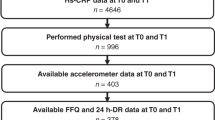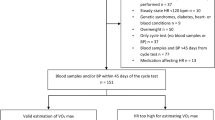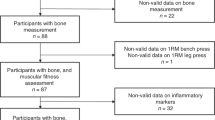Abstract
Hypothesis:
Basal insulin resistance (IR) and inflammation exacerbate post-exercise oxidative stress (OS) in overweight adolescent girls.
Design:
Cross-sectional study, effect of incremental ergocycle exercise until exhaustion on OS markers.
Participants:
Normal-weight (control) (n=17, body mass index (BMI): 20–24.2 kg/m2) and overweight adolescent girls (n=29, BMI: 24.1–36.6 kg/m2).
Measurements:
Dietary measurement, physical activity assessment (validated questionnaires), fat distribution parameters (by dual-energy X-ray absorptiometry and anthropometry) and maximal oxygen consumption (V̇O2peak). Blood assays include the following: (1) at fasting state: blood cell count, lipid profile, and IR parameters (leptin/adiponectin ratio (L/A), homeostasis model assessment of IR, insulin/glucose ratio; (2) before exercise: inflammation and OS markers (interleukin-6 (IL-6), C-reactive protein (CRP), myeloperoxidase (MPO), reduced glutathione/oxidized glutathione ratio (GSH/GSSG), 15 F2α-isoprostanes (F2-Isop), lipid hydroperoxides (ROOH), oxidized low-density lipoprotein (ox-LDL)) and antioxidant status (superoxide dismutase (SOD), glutathione peroxidase (GPX), vitamin C, α-tocopherol and β-carotene); and (3) after exercise: inflammation and OS markers.
Results:
At rest, overweight girls had a deteriorated lipid profile and significantly higher values of IR parameters and inflammation markers, compared with the control girls. These alterations were associated with a moderate rest OS state (lower GSH/GSSG ratio, α-tocopherol/total cholesterol (TC) ratio and GPX activity). In absolute values, overweight girls exhibited higher peak power output and oxygen consumption (V̇O2peak), compared with the control girls. Exercise exacerbated OS only in the overweight group (significant increase in F2-Isop, ROOH and MPO). As hypothesized, basal IR and inflammation state were correlated with the post-exercise OS. However, the adjustment of F2-Isop, ROOH and MPO variation per exercise V̇O2 variation canceled the intergroup differences.
Conclusion:
In overweight adolescent girls, the main factors of OS, after incremental exhaustive exercise, are not the basal IR and inflammation states, but oxygen overconsumption.
This is a preview of subscription content, access via your institution
Access options
Subscribe to this journal
Receive 12 print issues and online access
$259.00 per year
only $21.58 per issue
Buy this article
- Purchase on Springer Link
- Instant access to full article PDF
Prices may be subject to local taxes which are calculated during checkout


Similar content being viewed by others
References
Sibai AM, Hwalla N, Adra N, Rahal B . Prevalence and covariates of obesity in Lebanon: findings from the first epidemiological study. Obes Res 2003; 11/11: 1353–1361.
Ebbeling CB, Pawlak DB, Ludwig DS . Childhood obesity: public-health crisis, common sense cure. Lancet 2002; 360: 473–482. Review.
Daniels SR, Arnett DK, Eckel RH, Gidding SS, Hayman LL, Kumanyika S et al. Overweight in children and adolescents: pathophysiology, consequences, prevention, and treatment. Circulation 2005; 111/15: 1999–2012. Review.
Moran A, Jacobs Jr DR, Steinberger J, Hong CP, Prineas R et al. Insulin resistance during puberty: results from clamp studies in 357 children. Diabetes 1999; 48/10: 2039–2044.
Biro FM, Khoury P, Morrison JA . Influence of obesity on timing of puberty. Int J Androl 2006; 29/1: 272–277.
Stevens J, Murray DM, Baggett CD, Elder JP, Lohman TG, Lytle LA et al. Objectively assessed associations between physical activity and body composition in middle-school girls: the Trial of Activity for Adolescent Girls. Am J Epidemiol 2007; 166/11: 1298–1305.
Kopp HP, Kopp CW, Festa A, Krzyzanowska K, Kriwanek S, Minar E et al. Impact of weight loss on inflammatory proteins and their association with the insulin resistance syndrome in morbidly obese patients. Arterioscler Thromb Vasc Biol 2003; 23/6: 1042–1047.
Herder C, Schneitler S, Rathmann W, Haastert B, Schneitler H, Winkler H et al. Low-Grade Inflammation, Obesity, and Insulin Resistance in Adolescents. J Clin Endocrinol Metab 2007; 92/12: 4569–4574.
Sinaiko AR, Steinberger J, Moran A, Prineas RJ, Vessby B, Basu S et al. Relation of body mass index and insulin resistance to cardiovascular risk factors, inflammatory factors, and oxidative stress during adolescence. Circulation 2005; 111/15: 1985–1991.
Kelly AS, Steinberger J, Kaiser DR, Olson TP, Bank AJ, Dengel DR . Oxidative stress and adverse adipokine profile characterize the metabolic syndrome in children. J Cardiometab Syndr 2006; 1/4: 248–252.
Vincent HK, Taylor AG . Biomarkers and potential mechanisms of obesity-induced oxidant stress in humans. Int J Obes (Lond) 2006; 30/3: 400–418. Review.
Atabek ME, Vatansev H, Erkul I . Oxidative stress in childhood obesity. J Pediatr Endocrinol Metab 2004; 17/8: 1063–1068.
Van Gaal LF, Vertommen J, De Leeuw IH . The in vitro oxidizability of lipoprotein particles in obese and non-obese subjects. Atherosclerosis 1998; 137: S39–S44.
Strauss RS . Comparison of serum concentrations of alpha-tocopherol and beta-carotene in a cross-sectional sample of obese and non obese children (NHANES III). National Health and Nutrition Examination Survey. J Pediatr 1999; 134/2: 160–165.
Decsi T, Molnár D, Koletzko B . Lipid corrected plasma alpha-tocopherol values are inversely related to fasting insulinaemia in obese children. Int J Obes Relat Metab Disord 1996; 20/10: 970–972.
Molnár D, Decsi T, Koletzko B . Reduced antioxidant status in obese children with multimetabolic syndrome. Int J Obes Relat Metab Disord 2004; 28/10: 1197–1202.
Olusi SO . Obesity is an independent risk factor for plasma lipid peroxidation and depletion of erythrocyte cytoprotectic enzymes in humans. Int J Obes Relat Metab Disord 2002; 26/9: 1159–1164.
Zhu YG, Zhang SM, Wang JY, Xiao WQ, Wang XY, Zhou JF . Overweight and obesity-induced oxidative stress in children. Biomed Environ Sci 2006; 19/5: 353–359.
Alessio HM, Hagerman AE, Fulkerson BK, Ambrose J, Rice RE, Wiley RL . Generation of reactive oxygen species after exhaustive aerobic and isometric exercise. Med Sci Sports Exerc 2000; 32/9: 1576–1581.
Jammes Y, Steinberg JG, Brégeon F, Delliaux S . The oxidative stress in response to routine incremental cycling exercise in healthy sedentary subjects. Respir Physiol Neurobiol 2004; 144/1: 81–90.
Vincent HK, Vincent KR, Bourguignon C, Braith RW . Obesity and postexercise oxidative stress in older women. Med Sci Sports Exerc 2005; 37/2: 213–219.
Davì G, Guagnano MT, Ciabattoni G, Basili S, Falco A, Marinopiccoli M et al. Platelet activation in obese women: role of inflammation and oxidant stress. JAMA 2002; 288/16: 2008–2014.
Cole TJ, Bellizzi MC, Flegal KM, Dietz WH . Establishing a standard definition for child overweight and obesity worldwide: international survey. BMJ 2000; 320/7244: 1240–1243.
Heyman E, Delamarche P, Berthon P, Meeusen R, Briard D, Vincent S et al. Alteration in sympathoadrenergic activity at rest and during intense exercise despite normal aerobic fitness in late pubertal adolescent girls with type 1 diabetes. Diabetes Metab 2007; 33/6: 422–429.
Deheeger M, Rolland-Cahera MF, Fontvieille AM . Effet bénéfique de l'activité physique et de l'alimentation chez des enfants à l'âge de 12 ans. Information dietetique 1997; 3: 30–36.
Ainsworth BE, Haskell WL, Leon AS, Jacobs DR, Montoye HJ, Sallis JF et al. Compendium of physical activities: classification of energy costs of human physical activities. Med Sci Sports Exerc 1993; 25/1: 71–80.
Omaye ST, Tumbull JD, Sauerlich HE . Selected methods for the determination of ascorbic acid in animal cells, tissues and fluids. Methods Enzymol 1979; 62: 3–11.
Zhao B, Tham SY, Lai MH, Lee LK, Moochhala SM . Simultaneous determination of vitamins C, E and beta-carotene in human plasma by high-performance liquid chromatography with photodiode-array detection. J Pharm Pharm Sci 2004; 30: 200–204.
Sircar D, Subbaiah PV . Isoprostane measurement in plasma and urine by liquid chromatography-mass spectrometry with one-step sample preparation. Clin Chem 2007; 53/2: 251–258.
Van Beaumont W . Evaluation of hemoconcentration from hematocrit measurements. J Appl Physiol 1972; 32/5: 712–713.
Zimmet P, Alberti KG, Kaufman F, Tajima N, Silink M, Arslanian S et al. IDF Consensus Group. The metabolic syndrome in children and adolescents - an IDF consensus report. Pediatr Diabetes 2007; 8/5: 299–306.
Suzuki K, Ito Y, Ochiai J, Kusuhara Y, Hashimoto S, Tokudome S et al. Relationship between obesity and serum markers of oxidative stress and inflammation in Japanese. Asian Pac J Cancer Prev 2003; 4/3: 259–266.
Powers SK, Lennon SL, Quindry J, Mehta JL . Exercise and cardioprotection. Curr Opin Cardiol 2002; 17/5: 495–502.
Vincent HK, Powers SK, Stewart DJ, Shanely RA, Demirel H, Nalto H . Obesity is associated with increased myocardial oxidative stress. Int J Obes Relat Metab Disord 1999; 23: 67–74.
Dobrian AD, Davies MJ, Prewitt RL, Lauterio TJ . Development of hypertension in a rat model of diet-induced obesity. Hypertension 2000; 35: 1009–1015.
Roberts CK, Barnard RJ, Sindhu RK, Jurczak M, Ehdaie A, Vaziri ND . Oxidative stress and dysregulation of NAD(P)H oxidase and antioxidant enzymes in diet-induced metabolic syndrome. Metabolism 2006; 55/7: 928–934.
Mutlu-Türkoğlu U, Oztezcan S, Telci A, Orhan Y, Aykaç-Toker G, Sivas A et al. An increase in lipoprotein oxidation and endogenous lipid hydroperoxides in serum of obese women. Clin Exp Med 2003; 2/4: 171–174.
Risérus U, Vessby B, Arnlöv J, Basu S . Effects of cis-9, trans-11 conjugated linoleic acid supplementation on insulin sensitivity, lipid peroxidation, and proinflammatory markers in obese men. Am J Clin Nutr 2004; 80/2: 279–283.
Fujita K, Nishizawa H, Funahashi T, Shimomura I, Shimabukuro M . Systemic oxidative stress is associated with visceral fat accumulation and the metabolic syndrome. Circ J 2006; 70/11: 1437–1442.
Konukoglu D, Serin O, Turhan MS . Plasma leptin and its relationship with lipid peroxidation and nitric oxide in obese female patients with or without hypertension. Arch Med Res 2006; 37/5: 602–606.
Davì G, Falco A . Oxidant stress, inflammation and atherogenesis. Lupus 2005; 14/9: 760–764. Review.
Heinrich PC, Castell JV, Andus T . Interleukin-6 and the acute phase response. Biochem J 1990; 265/3: 621–636. Review.
Pérez-Martin A, Dumortier M, Raynaud E, Brun JF, Fédou C, Bringer J et al. Balance of substrate oxidation during submaximal exercise in lean and obese people. Diabetes Metab (Paris) 2001; 27: 466–474.
Zunquin G, Theunynck D, Sesboue B, Arhan P, Bougle D . Comparison of fat oxidation during exercise between lean and obese pubertal boys: clinical implications. Br J Sports Med 2008; 2 April 2008 [E-pub ahead of print].
Halliwell B, Whiteman M . Measuring reactive species and oxidative damage in vivo and in cell culture: how should you do it and what do the results mean? Br J Pharmacol 2004; 142: 231–255.
Viroonudomphol D, Pongpaew P, Tungtrongchitr R, Phonrat B, Supawan V, Vudhivai N et al. Erythrocyte antioxidant enzymes and blood pressure in relation to overweight and obese Thai in Bangkok. Southeast Asian J Trop Med Public Health 2000; 31/2: 325–334.
Viroonudomphol D, Pongpaew P, Tungtrongchitr R, Changbumrung S, Tungtrongchitr A, Phonrat B et al. The relationships between anthropometric measurements, serum vitamin A and E concentrations and lipid profiles in overweight and obese subjects. Asia Pac J Clin Nutr 2003; 12/1: 73–79.
Shin MJ, Park E . Contribution of insulin resistance to reduced antioxidant enzymes and vitamins in nonobese Korean children. Clin Chim Acta 2006; 365/1-2: 200–205.
Vincent HK, Bourguignon CM, Vincent KR, Weltman AL, Bryant M, Taylor AG . Antioxidant supplementation lowers exercise-induced oxidative stress in young overweight adults. Obesity (Silver Spring) 2006; 14/12: 2224–2235.
Goran M, Fields DA, Hunter GR, Herd SL, Weinsier RL . Total body fat does not influence maximal aerobic capacity. Int J Obes Relat Metab Disord 2000; 24/7: 841–848.
Hulens M, Vansant G, Lysens R, Claessens AL, Muls E . Exercise capacity in lean versus obese women. Scand J Med Sci Sports 2001; 11/5: 305–309.
Royer TD, Martin PE . Manipulations of leg mass and moment of inertia: effects on energy cost of walking. Med Sci Sports Exerc 2005; 37: 649–656.
Acknowledgements
This study was supported by the French-Lebanese cooperative research program (CEDRE), and was technically assisted by the University of Balamand (Lebanon) and the Laboratory of Probiox (Belgium). We thank Christophe Brandily for Isoprostanes assays development.
Author information
Authors and Affiliations
Corresponding author
Rights and permissions
About this article
Cite this article
Youssef, H., Groussard, C., Pincemail, J. et al. Exercise-induced oxidative stress in overweight adolescent girls: roles of basal insulin resistance and inflammation and oxygen overconsumption. Int J Obes 33, 447–455 (2009). https://doi.org/10.1038/ijo.2009.49
Received:
Revised:
Accepted:
Published:
Issue Date:
DOI: https://doi.org/10.1038/ijo.2009.49



